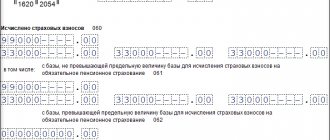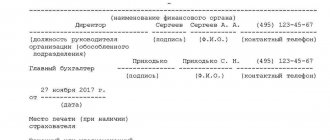Insurance premium rates in 2020
Insurance premiums in 2020 include maternity and sickness premiums, medical premiums, pension contributions and personal injury contributions. Their total rate is 30% plus an accident insurance premium rate, which depends on the hazard of the operation.
Contributions to compulsory pension insurance: if the amount of payments to an individual employee does not exceed 1,150,000 rubles, then the rate is 22%; if the amount of payments to an individual employee exceeds RUB 1,150,000, then the rate is +10% on payments above the base.
Contributions for compulsory health insurance: rate 5.1%.
Contributions for insurance in case of temporary disability and maternity: if the amount of payments to an individual employee did not exceed 865,000 rubles, then the rate is 2.9%; if it exceeds 865,000 rubles. — 0%, that is, there are no payments over the limit.
Employer rates
If the employer does not belong to a special category of taxpayers who pay under preferential or stricter conditions, contributions for employee insurance are calculated based on the basic tariffs.
| Type of insurance | Basic tariff | Base |
| Pension | 22 | Article 426 Tax Code, clause 1 |
| Social | 2,9 | Article 426 Tax Code, clause 2. |
| Medical (compulsory medical insurance) | 5,1 | Article 426 Tax Code, clause 3 |
The legislation provides for a maximum tax base for contributions to the Social Insurance Fund and Compulsory Social Security. This means that the total amount of payments for the entire tax period (year), which is subject to contributions at standard rates, is up to 1 million 21 thousand rubles in the Pension Fund and 815 thousand rubles in the Social Insurance Fund. Payments exceeding this limit for pension benefits are subject to a 10% levy. However, these data are relevant for 2020; for 2019, the maximum tax base has not yet been established. The State Duma introduced bill No. 387959-7, which proposed to completely abolish the tax limit. However, this project was rejected.
Note. Contributions from enterprises whose activities involve a risk of injury are also provided. They are determined according to the rates fixed in the Law of December 22, 2005 N 179-FZ. For the possibility of injury and occupational diseases, the organization pays from 0.2% to 8.5%, depending on the risk class.
Reports to extra-budgetary funds for 2020
Resolution of the Board of the Pension Fund of the Russian Federation dated January 11, 2017 No. 3p approved three reporting forms and one accompanying explanatory form for them.
Since the new year, some adjustments have been made to the forms. And these changes must be taken into account, since reporting for 2020 must be done using new forms approved by Resolution of the Board of the Pension Fund of the Russian Federation dated December 6, 2018 No. 507P:
- SZV-STAZH
The updated form must be submitted by March 1, 2020. No changes have been made to completing this form. However, in section 3 in column 14, the title was expanded with the following wording: “information about the periods counted in the insurance period of the unemployed.”
The form includes all employees who received monetary rewards from which insurance premiums were paid. That is, employment contracts, civil contracts, and copyright contracts are taken into account.
If one employee in the reporting year was registered as a full-time employee, was also on leave without pay, took sick leave, etc., then all these periods, in accordance with personnel orders, must be reflected in the SZV-STAZH form, since this affects for calculating the employee's pension.
The accompanying document EDV-1 to the SZV-STAZH form is prepared automatically and does not cause any problems. It removed the line “Other incoming documents” from section 3 “List of incoming documents”.
- SZV-KORR
Using this form, previously submitted information is corrected if the company, independently or as a result of checking the PF, has discovered any errors (for example, some periods were not taken into account in the length of service). An accompanying EFA-1 document is also being prepared for this form.
- SZV-ISH
This form is presented for periods that expired before January 1, 2017, and actually serves to correct errors of previous periods. Form EDV-1 is also filled out for it.
It is worth noting some changes that have occurred in correcting errors in the SZV-M form.
On October 1, 2020, Order of the Ministry of Labor No. 385n dated June 14, 2018 came into force, which amended the Instructions on the procedure for maintaining accounting records and clearly regulated the algorithm for correcting errors in the SZV-M form. It lies in the fact that the Pension Fund, having discovered an error, is obliged to notify the payer of insurance premiums within five days that an authorized person has identified false information. The company, in turn, undertakes to correct the error within five calendar days for the insured person for whom it was identified. If the payer manages to do this within five days, then no fines are applied to him.
That is, the Instructions now clearly indicate that updated information is provided only for those insured persons in respect of whom an error warning was received.
There is another significant innovation, which is associated with the application of sanctions in the event of self-identification and correction of errors. Previously, if the company itself identified an error and eliminated it before it came to the attention of the Pension Fund, there were no grounds for a fine. Now sanctions are not applied if two conditions are simultaneously met: the policyholder independently discovered an error in the previously submitted information and corrected it before the Pension Fund found out about it, and the erroneous information was accepted by the Pension Fund.
New reporting on contributions
The procedure for calculating insurance premiums in 2020, as it was before, has not changed. To calculate them, the following components are taken into account:
- Deductions in favor of individuals.
- Established tariff rates for insurance premiums, depending on the amount that is subject to insurance premiums.
- Approved maximum values of the taxable base.
Let's look at each component of calculating insurance premiums in more detail.
From payments to employees, employers are required to deduct insurance premiums for such types of compulsory insurance as:
- medical;
- pension;
- social.
Let us remind you that insurance premiums must be accrued for remuneration to the head of the organization (even without an employment contract concluded with him) and those employees who work in accordance with:
- with employment contracts;
- with civil contracts (for the provision of services or performance of work);
- with copyright agreements (with performers).
Please note that in 2020, the calculation of insurance premiums for remuneration of individuals concerns not only cash, but also in kind.
Article 422 of the Tax Code of the Russian Federation provides a list of payments that are not subject to insurance premiums.
Insurance contributions to the Pension Fund for the additional tariff are paid in the same way as for the main one - every month based on the results of the previous one. At the same time, the timing of the transfer of funds also coincides with the payment of contributions at the basic tariff, namely no later than the 15th day of the following month after the reporting month.
- Insurance premiums, both basic and additional, are transferred to the Federal Tax Service, since since 2020 the Tax Service is the administrator of contributions to the Pension Fund.
- In this regard, the KBK for transferring contributions now begins with “182” - this is the administrator code assigned by the Federal Tax Service.
The amount of insurance premiums in 2020 remains at the same level. Now the general tariffs for 2017-2018 for policyholders-employers will be set by Article 426 of the Tax Code of the Russian Federation. Those who are not entitled to a reduced tariff calculate contributions from employee benefits as follows:
- If payments to the employee do not exceed the maximum base, the tariffs will be:
Pension Fund – 22%,
Social Insurance Fund (temporary disability and maternity) – 2.9%,
- If the base limit is exceeded:
Pension Fund on the excess amount – 10%,
Social Insurance Fund (temporary disability and maternity) - not accrued.
- The MHIF does not depend on the maximum values, contributions are accrued without restrictions - 5.1%.
Reduced insurance premium rates will remain in 2020, and no changes are expected for them compared to 2020. Chapter 34 of the Tax Code now describes in more detail the conditions for applying reduced tariffs, and for some of them additional requirements for policyholders have been added (Article 427 of the Tax Code of the Russian Federation).
The maximum base of insurance premiums for 2020 has not yet been approved, but a draft resolution of the Government of the Russian Federation is already being discussed, in which the limits will be increased to the following amounts:
- for FSS contributions – 755,000 rubles (in 2020 the base is 718,000 rubles),
- for Pension Fund contributions – 876,000 rubles (in 2020, the base is 796,000 rubles).
When calculating insurance premiums, the base for accrual for 2017 will continue to include payments and other remuneration under employment and civil law contracts in favor of individuals who are subject to compulsory social insurance (Article 420 of the Tax Code of the Russian Federation). The base must be calculated incrementally from the beginning of the year. If the employee did not get a job from the beginning of the pay period, then payments at the previous place of work are not included in the calculation.
In the case where an employee quit, but in the same year returned to the same place of work, the base for calculating contributions will include all payments accrued to this employee in the organization for the entire billing period. That is, for the entire time that the employee worked there for a year (letter of the Ministry of Labor of the Russian Federation dated March 5, 2014 No. 17-3/B-96).
Individual entrepreneurs will continue to pay fixed contributions to the Pension Fund and the Compulsory Medical Insurance Fund, as well as 1% to the Pension Fund on excess income.
We will continue to pay contributions for “injuries” to the Social Insurance Fund in 2020. Their tariff will still be determined by the class of professional risk of the policyholder's main activity. Before April 15, 2020, you need to confirm your right to the applicable tariff by providing a certificate confirming the main type of activity, otherwise the Social Insurance Fund has the right to apply a higher rate for the highest class of profit insurance (Resolution of the Government of the Russian Federation dated June 17, 2016 No. 551).
For all contributions starting from 2020, one summary report is submitted, which will be submitted to the Federal Tax Service on a quarterly basis. The deadline for its submission is the 30th day of the month following the reporting quarter (clause 7 of Article 431 of the Tax Code of the Russian Federation). For the first time, we will have to submit reporting on contributions to the tax office based on the results of the 1st quarter of 2020.
At the same time, we will continue to submit to the FSS the updated report 4-FSS-2017 regarding injuries, and to the Pension Fund of Russia a monthly report SZV-M and a new annual report with information on experience. Updated reports for all periods before 2020 will be submitted to the same funds.
As it turned out, new tariff rates, changes in the calculation procedure and other radical innovations in calculating insurance premiums do not yet threaten anyone. But it is obvious that by the end of the year it is inevitable that the maximum base for calculating contributions will increase, the adoption of new BCC and details for transferring funds to the Federal Tax Service, and also in the new year it will be necessary to fill out and submit reports on new forms, not only to the tax office, but also to funds.
The deadlines for transferring insurance payments do not change, and as before, the cutoff date for transferring the premium is the 15th of the month following the reporting period. This rule was approved in clause 3 of Article 431 of the Tax Code of the Russian Federation, and all payments must still be made in rubles and kopecks, and rounding is not acceptable.
The completed document must be submitted no later than the 30th day of the month following the billing (reporting) period. This norm is approved by tax legislation, and you can familiarize yourself with it in paragraph 7 of Article 431 of the Tax Code of the Russian Federation. If the report is submitted by a legal entity that officially has a staff of more than 25 people, then the accounting department will also have to provide the tax authorities with the calculation in electronic form.
However, the innovations will affect not only reporting to tax authorities, but also to extra-budgetary funds. Previously accepted forms have been completely abolished, and therefore new forms of reporting documentation will be introduced.
Amendments have been made to clause 2.2 of Article 11 of the Law “On Personalized Accounting” regarding the deadlines for submitting documentation. If previously the report had to be submitted by the 10th of the month following the reporting month, now the deadline has been postponed to the 15th.
Filling out
section 3 calculation of insurance premiums in 2020
, you first need to analyze information about the list of persons and organizations submitting the document.
Find out how to fill out adjusting financial statements in our article.
Here you can find out about the deadlines for submitting SZV-M for December 2019.
Although from 2020 all functions for monitoring the payment of contributions (except for contributions for injuries) are transferred to the Federal Tax Service, there remains reporting that must be submitted to the funds.
Pension Fund:
- monthly SZV-M - no later than the 15th day of the month following the reporting month (previously it was until the 10th);
- once a year, personalized accounting information (SZV-Experience) - no later than March 1, 2020 for 2020.
VSocial Insurance Fund:
- updated form 4-FSS, deadlines are the same - no later than the 20th day of the month following the reporting quarter (on paper) and no later than the 25th day for electronic reporting (if the number of employees is more than 25 people).
A single calculation is submitted to the tax inspectorate, which combines information that was previously included in the RSV and 4-FSS forms. A single calculation of contributions must be submitted no later than the 30th day following the reporting period (clause 7 of Article 431 of the Tax Code of the Russian Federation).
Calculation of insurance premiums in 2020
From January 1, 2020, several important innovations related to the calculation of insurance premiums are in effect. They shouldn't be ignored either.
Firstly, the grace period for applying reduced rates for an entire category of policyholders has ended. Enterprises on the simplified tax system engaged in industrial production, agriculture, transport, and construction lost their benefits. Previously, according to Letter of the Ministry of Finance dated January 25, 2018 No. 03-15-06/3961, they had preferences if several conditions were met at once.
The same benefit, in accordance with Federal Laws No. 303-FZ and No. 300-FZ dated August 3, 2018, was lost by:
- enterprises on the simplified tax system;
- pharmacies on UTII;
- entrepreneurs with patents.
From 2020, they must pay insurance premiums on a general basis.
Who does the reduced insurance premium rate apply to:
- for non-profit and charitable organizations under the simplified tax system (extended until 2024). Such policyholders will continue to pay only pension contributions at a rate of 20%.
- for companies working in information technology, for residents of the Skolkovo project, free economic zones, etc.
In connection with the current changes, you should pay attention to the Letter of the Federal Tax Service of Russia dated December 26, 2018 N BS-4-11 / [email protected] It explains how to fill out the calculation of insurance premiums due to the fact that from January 1, 2020, some payers insurance premiums lose the right to apply reduced rates.
So, in particular, when filling out the calculation for the first quarter of 2020, such payers need to indicate the payer’s tariff code “01” and the corresponding category code of the insured person (“NR”, “VZHNR”, “VPNR”).
The Letter of the Federal Tax Service of Russia dated December 20, 2018 No. BS-4-11/ [email protected] recalls the calculation procedure and provides an algorithm for calculating insurance premiums when combining two jobs.
OKVED codes for 2020 at reduced rates
On January 1, 2020, Rosstandart introduced OKVED2 instead of OKVED1. However, despite the transitional keys, not all old activity codes coincided with the new ones. Because of this, starting from 2020, not all organizations could apply reduced insurance premium rates.
As can be seen from the table above, organizations and individual entrepreneurs that are engaged in a certain type of business (activity) have the right to apply reduced tariffs in 2020. Each type of such “preferential” activity must correspond to a specific code, which is assigned to it in accordance with the all-Russian classifier in force in 2020.
In the table below we have summarized the OKVED codes, which in 2020 correspond to the reduced rates of insurance premiums that organizations and individual entrepreneurs using the “simplified tax” have the right to apply.
| Types of activities OKVED for reduced tariffs under the simplified tax system in 2020 | |
| Main activity in 2020 | OKVED code 2 |
| food production | 10 |
| production of mineral waters and other non-alcoholic drinks | 11.07 |
| textile and clothing production | 13, 14 |
| production of leather, leather goods and footwear production | 15 |
| wood processing and production of wood products | 16 |
| chemical production | 20 |
| production of rubber and plastic products | 22 |
| production of other non-metallic mineral products | 23 |
| production of finished metal products | 25 |
| production of machinery and equipment | 28 |
| production of electrical equipment, electronic and optical equipment | 26, 27 |
| production of vehicles and equipment | 29, 30 |
| furniture manufacture | 31 |
| production of sporting goods | 32.3 |
| production of games and toys | 32.4 |
| research and development | 72 |
| education | 85 |
| health and social services | 86, 87, 88 |
| activities of sports facilities | 93.11 |
| other activities in the field of sports | 93.19 |
| processing of secondary raw materials | 38.3 |
| construction | 41, 42, 43 |
| vehicle maintenance and repair | 45.2 |
| collection of waste water, waste and similar activities | 37, 38.1, 38.2 |
| transport and communications | 49–53 |
| provision of personal services | 96 |
| production of cellulose, wood pulp, paper, cardboard and products made from them | 17 |
| production of musical instruments | 32.2 |
| production of various products not included in other groups | 32.9 |
| repair of household products and personal items | 95.2 |
| real estate management | 68.2, 68.32 |
| activities related to the production, distribution and screening of films | 59.11–59.14 |
| activities of libraries, archives, club-type institutions (except for the activities of clubs) | 91.01 |
| activities of museums and protection of historical sites and buildings | 91.02, 91.03 |
| activities of botanical gardens, zoos and nature reserves | 91.04 |
| activities related to the use of computer technology and information technology (except for organizations and entrepreneurs specified in subparagraphs 2 and 3 of paragraph 1 of Article 427 of the Tax Code of the Russian Federation) | 63 |
| retail trade of pharmaceutical and medical goods, orthopedic products | 47.73, 47.74 |
| production of bent steel profiles | 24.33 |
| steel wire production | 24.34 |
We suggest you read: Registration of a car without insurance
Fixed contributions for individual entrepreneurs in 2020
Until 2020, insurance premiums for individual entrepreneurs were paid based on the cost of the insurance year. That is, the cost of the insurance year was calculated according to the formula: minimum wage X 12 months.
Since January 1, 2020, the minimum wage has increased by almost 30%. And in order to avoid excessive burden on individual entrepreneurs, from 2020 it was decided to decouple the amount of insurance premiums from the minimum wage and introduce fixed contributions for entrepreneurs.
Open an account with Kontur.Bank and use built-in accounting and reporting. Corporate card and electronic signature are free. Up to 5% on balance.
To learn more
For 2020, fixed contributions for individual entrepreneurs were:
- For compulsory pension insurance: if the income of an individual entrepreneur does not exceed 300,000 rubles, then the fixed amount is 29,354 rubles. (in 2018 - 26,545 rubles); if the income of an individual entrepreneur is more than 300,000 rubles, then the fixed amount is 29,354 rubles. + 1% of the amount of income exceeding 300,000 rubles, but not more than an eightfold increase in the fixed payment - 8 x 29,354 rubles. Thus, the maximum contribution for compulsory pension insurance in 2020 is RUB 234,832. (in 2020 - 212,360 rubles).
- For compulsory health insurance - 6,884 rubles. (in 2018 - 5,840 rubles).
Individual entrepreneurs, as before, are not required to transfer contributions in case of temporary disability and in connection with maternity “for themselves”.
Who can work for the simplified tax system and do “simplified” workers pay insurance premiums?
The possibility of using the simplified taxation system (STS) is available to legal entities and individual entrepreneurs that meet certain restrictions established by Art.
346.12 Tax Code of the Russian Federation. These restrictions also include engaging in certain types of activities. At the same time, most existing types of activities can be transferred to the simplified tax system. Read about the conditions for applying the simplified tax system in 2019-2020 here.
The presence of hired personnel in organizations and individual entrepreneurs allows them to be regarded as persons who pay remunerations and are obliged to pay insurance premiums from these remunerations (subparagraph 1, paragraph 1, article 419 of the Tax Code of the Russian Federation, article 3 of the law “On Compulsory Social Insurance...” dated July 24, 1998 No. 125-FZ).
An individual entrepreneur may not have employees and, accordingly, will not pay remuneration to them. But he must also pay contributions (subclause 2, clause 1, article 419 of the Tax Code of the Russian Federation), although in a different order from that which applies to hired employees (Articles 421, 422, 430 of the Tax Code of the Russian Federation).
An individual entrepreneur with employees will have to pay contributions simultaneously on 2 grounds (clause 2 of Article 419 of the Tax Code of the Russian Federation):
- for myself;
- from the remuneration of these employees.
Organizations and individual entrepreneurs using the simplified tax system can apply reduced tariffs if they are engaged in certain types of activities. To do this, two basic conditions must be met:
- income from this type of activity constitutes at least 70 percent of the total amount of all receipts for the reporting period (that is, from the beginning of the year);
- the total amount of income does not exceed 79,000,000 rubles.
This is stated in subparagraph 5 of paragraph 1, subparagraph 3 of paragraph 2, paragraphs 3 and 6 of Article 427 of the Tax Code of the Russian Federation.
KBC for insurance premiums for 2020
Updated BCCs for entrepreneurs are given in Order of the Ministry of Finance of the Russian Federation dated June 8, 2018 N 132N.
BCC for insurance contributions for compulsory pension insurance, which are credited to the Pension Fund (fixed payment):
- contributions – 182 1 0210 160
- penalties – 182 1 0210 160;
- fines – 182 1 0210 160.
BCC for insurance premiums for compulsory health insurance, which are credited to the Compulsory Medical Insurance Fund:
- contributions – 182 1 0213 160;
- penalties – 182 1 0213 160;
- fines – 182 1 0213 160.
What to do with professional income tax payers?
Since January 1, 2020, Federal Law No. 422-FZ of November 27, 2018 has been in force, which introduces an experiment to establish a special tax regime for self-employed citizens. The so-called professional income tax is valid in Moscow, the Moscow region, the Kaluga region and the Republic of Tatarstan.
It is important for companies to know that they can sign civil agreements with a person registered as a professional income tax payer, but as with an individual who is a professional income tax payer. Having received confirmation through the tax service website that the subject is using the new special regime, companies do not need to withhold or accrue any amounts from their income to the Pension Fund, Social Insurance Fund and Compulsory Medical Insurance Fund.
New report to the Pension Fund from 2020 SZV-TD: form and content
The form of the new report was approved by the Pension Fund of Russia (Resolution of the Board dated December 25, 2019 No. 730p). It is called “Information on the work activity of a registered person” and has the abbreviation SZV-TD. The form consists of a header and a table. In the header you need to indicate:
- information about the employer: its registration number in the Pension Fund, name, tax identification number and checkpoint;
- information about the employee: full name, date of birth, SNILS;
- information about his choice of method of maintaining a work record book;
- reporting period: month serial number (01–12) and reporting year.
The table includes 10 columns:
- Serial number (column 1).
- Information about the person’s work activity: admission, transfers, dismissal, indicating the date, name of the position and structural unit, links to the relevant norm of the Labor Code of the Russian Federation, as well as details of the order (columns 2–9).
IMPORTANT! When submitting information about an employee for the first time, the first line should include the most recent personnel event according to his work record as of 01/01/2020.
- Sign of cancellation of recording information about admission, transfer, dismissal (column 10). The column is filled out if it is necessary to cancel an entry in the information previously provided by the policyholder. In this case, the form is filled out exactly as the original one, and an X is placed in column 10.
You can download the new form on our website.
And in this article you can view and download a completed sample of SZV-TD.
As for the responsibility for failure to submit a new report to the Pension Fund, you can read about it in the Guide from ConsultantPlus “Information on labor activity (electronic work book)”, having received free access.
Re-registration in social insurance for “injuries” for 2020
Federal Law No. 477-FZ dated December 25, 2018 fixed the rates of insurance premiums for injuries for 2020, 2020 and 2021. That is, they are not subject to promotion. The current preferential rates of insurance premiums (in the amount of 60% of the established amount) for individual entrepreneurs in relation to payments to employees who are disabled people of groups I, II and III are also preserved.
The deadline for submitting a certificate of confirmation of the main area of activity and an application for confirmation of the insurance tariff remains until April 15.
Therefore, when companies prepare reports for the first quarter of 2020, in particular, the 4-FSS statement for 2020, they need to take into account the new tariffs that were established based on the results of 2018. To the FSS department where they are registered as payers of insurance premiums for injuries, they must submit:
- certificate confirming the main activity
- application for setting a tariff in accordance with the main type of activity
These documents can be submitted personally to the Social Insurance Fund employee by the head or his authorized representative, sent by post or courier, or transmitted in electronic format using the government services website.
If a company ignores this obligation and does not submit the necessary documents, the tariff will be assigned to it by default (the FSS will select the OKVED register of legal entities with the maximum injury rate and set a coefficient and percentages for it).
New list and new codes
| OKVED code 2 | Name of the grouping of activities from the list given in the Tax Code |
| 10 | Food production |
| 11.07 | Production of soft drinks, production of mineral waters and other bottled drinking waters |
| 13 | Textile production |
| 14 | Manufacture of wearing apparel |
| 15 | Production of leather and leather products |
| 16 | Wood processing and production of wood and cork products, except furniture, production of straw products and wicker materials |
| 17 | Production of paper and paper products |
| 20 | Production of chemicals and chemical products |
| 21 | Production of medicines and materials used for medical purposes |
| 22 | Production of rubber and plastic products |
| 23 | Production of other non-metallic mineral products |
| 24.33 | Production of profiles using cold stamping or bending |
| 24.34 | Wire production using cold drawing method |
| 25 | Production of finished metal products, except machinery and equipment |
| 26 | Production of computers, electronic and optical products |
| 27 | Electrical Equipment Manufacturing |
| 28 | Production of machinery and equipment not included in other categories |
| 29 | Production of motor vehicles, trailers and semi-trailers |
| 30 | Manufacture of other vehicles and equipment |
| 31 | Furniture manufacture |
| 32.2 | Production of musical instruments |
| 32.3 | Production of sporting goods |
| 32.4 | Production of games and toys |
| 32.5 | Production of medical instruments and equipment |
| 32.9 | Production of products not included in other groups |
| 33 | Repair and installation of machinery and equipment |
| 37 | Wastewater collection and treatment |
| 38 | Collection, processing and disposal of waste, processing of secondary raw materials |
| 41 | Building |
| 42 | Construction of engineering structures |
| 43 | Specialized construction works |
| 45.2 | Vehicle maintenance and repair |
| 47.73 | Retail trade of medicines in specialized stores (pharmacies) |
| 47.74 | Retail trade of products used for medical purposes, orthopedic products in specialized stores |
| 49 | Activities of land and pipeline transport |
| 50 | Water transport activities |
| 51 | Air and space transport activities |
| 52 | Warehousing and auxiliary transport activities |
| 53 | Postal and courier activities |
| 59.1 | Production of films, videos and television programs |
| 60 | Activities in the field of television and radio broadcasting |
| 61 | Activities in the field of telecommunications |
| 62 | Computer software development, consulting services in the field and other related services |
| 63 | Activities in the field of information technology |
| 68.32 | Real estate management on a fee or contract basis |
| 72 | Research and development |
| 75 | Veterinary activities |
| 79 | Activities of travel agencies and other organizations providing services in the field of tourism |
| 81 | Maintenance activities for buildings and grounds |
| 85 | Education |
| 86 | Health activities |
| 87 | Residential care activities |
| 88 | Providing social services without providing accommodation |
| 90.04 | Activities of cultural and art institutions |
| 91 | Activities of libraries, archives, museums and other cultural facilities |
| 93.11 | Activities of sports facilities |
| 93.12 | Activities of sports clubs |
| 93.13 | Activities of fitness centers |
| 93.19 | Other activities in the field of sports |
| 95 | Repair of computers, personal and household items |
| 96 | Activities providing other personal services |
We suggest you read: Refund of insurance by credit card










